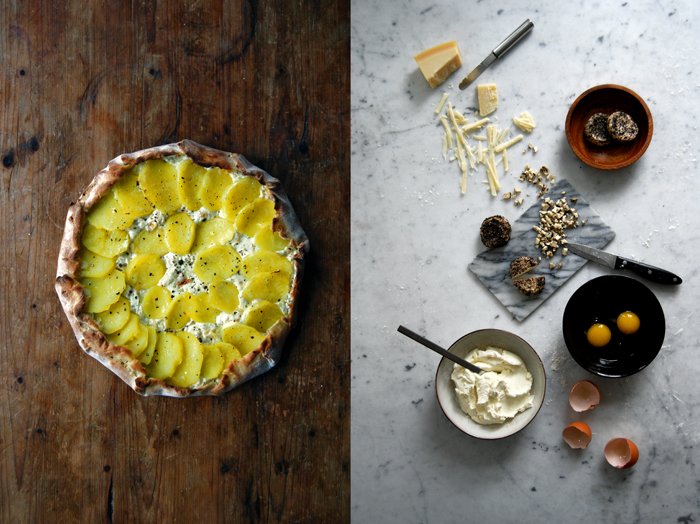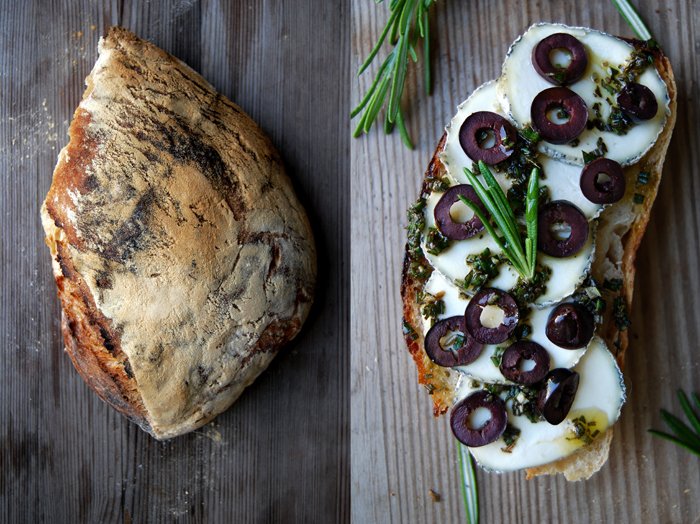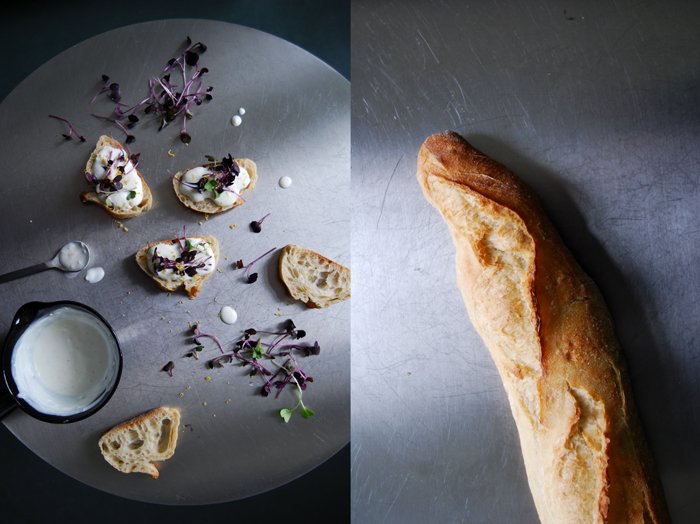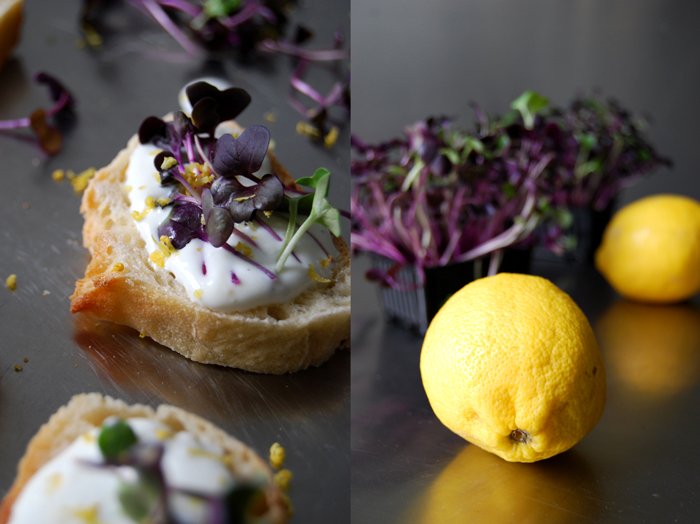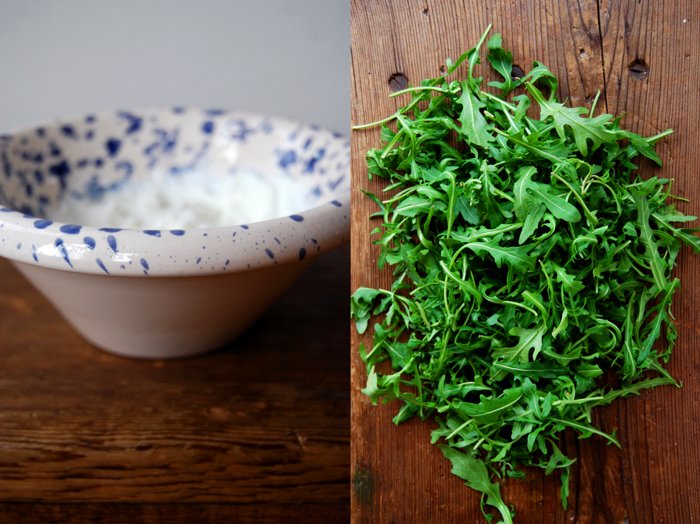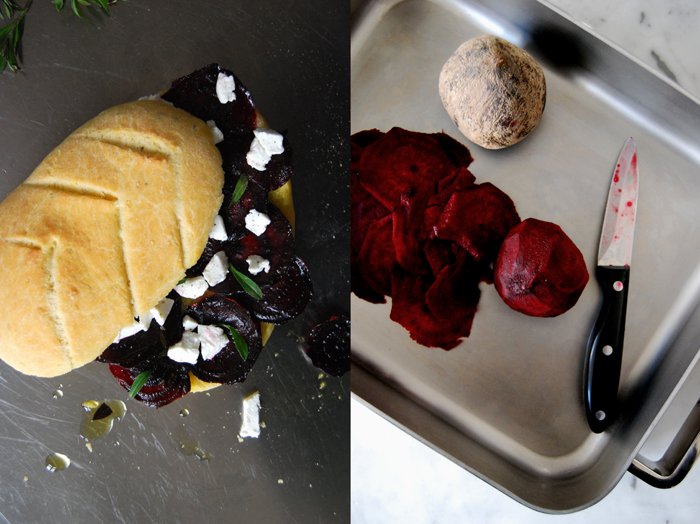meet in your kitchen | Alex's Kusksu Soup with Beans, Goat Cheese & Eggs
I'm in love - with my dear Maltese / British kitchen hosts Alex and Benjamin, with their beautiful 400 year old palazzo in Zebbug, their wonderful friends who joined us for a delicious traditional lunch and with the most gorgeous kitchen island I've ever seen in my life. A huge slab of Carrara marble on top of a simple wooden shelf took my breath away as I walked into the gorgeous kitchen. It's one of those rooms that you never want to leave again. It's welcoming and cozy, with an old fire place on one side, sparkling copper pots and pans hanging on a long limestone wall and a rustic wooden table at a glass door facing a bright courtyard. Here, you can cook, bake, chop and stir in peace and with plenty of space. A lot of the fresh produce comes straight from the garden, the cheese is made by a lady who lives in the village and Alex has enough ideas, energy and creativity to throw fantastic dinner parties on a weekly basis. It's my Mediterranean heaven.
The house is a gem and every detail feels effortlessly right. Found and restored by Alex more than 20 years ago, he saw the old walls' beauty built of thick Maltese limestone. The charismatic man used his sense and sensitivity to bring his home's true soul to life. Alex believes that everybody can create a nice house but not necessarily a home - a home needs a past, present and future and this palazzo has plenty of them all. It's a peaceful oasis, tranquil and calm, in the middle of an ancient village. Hidden doors and winding corridors, steps and balustrades cut out of the island's typical golden stone turn it into a playful labyrinth. The rooms furnished with elegant antiques are surrounded by walls more than 1m (3 feet) thick, the charm is rather introverted, here, the focus isn't on the world outside but surprises with dreamy views onto the lush green garden and into the courtyard with an almost cloistral atmosphere.
We met to cook and what is more fitting in this scene than an old Maltese recipe - the traditional Kusksu. The locals call it peasant food, I call it the most comforting, nurturing and scrumptious soup. Thick like a runny risotto, it's made with lots of onions, concentrated tomato paste, fava beans and peas, enriched with Maltese short cut pasta - the Kusksu pasta resembling couscous - eggs poached in the fruity juices and Gbejna, the islands' fresh goat cheese. The soft egg and cheese melt into the soup and spread their fine flavors, it's delicious!
Alex uses the tasty greens from their garden in Gozo, Malta's sister island. The fertile soil around another old house of his - this time from the 18th century - supplies the passionate cook and his food loving sous chef Benjamin with fresh produce all year round. I have only seen pictures of Casa Mezzodì in the village of Kercem but it looks like paradise.
Alex loves to use his self-taught kitchen skills to treat his friends to casual lunches and extravagant dinner parties. I'm very happy to be one of them, thanks to Benjamin who I've been visiting for years due to his amazing treatments. Originally from London, Benjamin left England a while ago to live with his partner on the Mediterranean archipelago and work as a reflexologist. He is simply the best, he knows the foot map and its pressure points so well that I trust him blindly.
Kusksu - Maltese Pasta Soup with Beans, Peas, Eggs and Goat Cheese
Adapted from the fantastic 'The Food and Cookery of Malta' by Anne and Helen Caruana Galizia.
Serves 4
olive oil
medium sized onions, thinly sliced, 2
garlic, crushed, 2 cloves
tomato paste 3-4 tablespoons
water 2l / 8 1/2 cups
fava beans, fresh or frozen, shelled, the outer skin removed, 350g / 12 1/2 ounces
bay leaves 2
peperoncino, chopped, to taste
salt and pepper
Kusksu pasta (or any other rice-shaped pasta) 100g / 3 1/2 ounces
peas, fresh or frozen, shelled, 200g / 7 ounces
eggs 4-8
small fresh goat cheeselets (like Maltese Gbejna or soft Chèvre) 4-8
Parmesan, freshly grated
Heat a generous splash of olive oil in a large pan and soften the onions and garlic for about 10-15 minutes, they should be golden but not dark. Add the tomato paste and cook for 1 minute. Pour in the water, stir in the beans, bay leaves and peperoncino and season with salt and pepper. Simmer for about 30 minutes or until the beans are al dente. Add the pasta and cook on low heat for about 10 minutes, stir once in a while. Add the peas, take the pan off the heat, cover and let it sit for about 10 minutes. Season to taste. Gently slip the eggs and goat cheeselets into the hot soup and let them cook, covered, on low heat for a few minutes. Serve the soup when the egg whites are still slightly soft, sprinkle with Parmesan and black pepper.
What fascinates you about old houses - and especially - their restoration?
I have been very privileged in my life to have been able to do a job I thoroughly enjoy. In my opinion, old houses allow us to revisit the past, which although can never be recreated, is fascinating to dip in to. It gives me a great deal of personal satisfaction to revitalise a period building and adapt it to contemporary living, whilst preserving the atmosphere and charm of past centuries.
You collect antiques. Some say it's impossible to stop collecting once you got started, do you feel the same? Where do you look for new finds?
Some of us suffer from Horror Vacui, and I suppose it is fair to say that there is a magpie in all of us. However, jesting apart, an old house needs props, rather like a stage and it is the love of old houses which leads one to forming collections.I mainly find things at auctions and house clearance sales. I also like rummaging on the barrows at Portobello Road whenever I happen to be in London.
As a passionate cook you host wonderful lunches and dinner parties for your friends. How important are these gatherings for you?
I am a very gregarious person by nature and nothing gives me greater pleasure than to see friends and family gathered round the table sharing food I have prepared. Besides, houses need to be filled with laughter and friends, and our house really comes alive when we give a dinner or a lunch party. As my partner is British, we frequently have house guests to stay. This always presents an opportunity ask our Maltese friends to lunch or dinner to meet them.
When did you start cooking and who or what was your inspiration?
As I have always been (overly!) fond of my food, I remember experimenting with recipes at about 16. Although, I suppose that I started taking cooking seriously in my twenties. One of my earliest inspirations was the great Elizabeth David, who pushed boundaries in her time and was seminal in bringing the Mediterranean cuisine to the rest of Europe. Malta at the time was still very British, with a tendency towards food of the meat and two veg variety, in spite of the great choice of Mediterranean vegetables available in local markets. I discovered a worn paperback copy of Elizabeth David’s Italian Food in the local RSPCA second hand bookshop, and it was this publication that flung open the doors for using local ingredients, and I still dip in to it to this day. Later on I discovered The Food and Cookery of Malta by Anne and Helen Caruana Galizia, and this publication has been my most thumbed cookery book since, as it revives all the traditional and wonderful Maltese dishes.
Some of the fresh produce you use in your kitchen is grown by your gardner in Gozo, from Malta's sister island, where you also spend a lot of your time. What are the differences between living in Malta and in Gozo?
We are very fortunate to have a weekend house called Casa Mezzodì in the village of Kercem in Gozo, where the garden is looked after by a very special man called George Spiteri. George is passionate about growing indigenous crops using organic methods, and we are very privileged to be able to have these vegetables made available to us.Gozo is essentially composed of rural communities living off the land and the sea. In spite of the close proximity, Gozitan kitchens produce different fare to Maltese ones. Gozitans being particularly inventive with stretching ingredients, creating delicious pies and stews made with the wonderful vegetables and fresh fish available.While we rarely venture out to restaurants in Malta, in Gozo we take every opportunity to visit the charming fishing village, turned resort, of Xlendi which is a mere five minutes from our home. There, we visit our favourite waterfront restaurants, and especially enjoy the cheese-less Gozitan “pizza” or ftira as it is known locally, which is topped with unusual layers of thinly sliced potato, tomatoes, capers, olives, anchovies and onions. The freshness of the ingredients, without the heaviness of cheese, on the crispiest of bases is the most heavenly combination.
What do you love about the Maltese cuisine?
The most simple, and frugal of ingredients, are always transformed into delicious dishes, which never fail to please. The stuffing of vegetables with rice, or meat, or fish…the wonderful pies, the vegetable stews, all combine European and Arabic influences and truly reflect Malta’s extraordinary geographical location at the crossroads between North, South, East and West.
Where do you find inspiration for new creations in the kitchen?
This wonderful age of communication has meant that one can browse for hours through fascinating blogs, such as yours, exploring new territory. In a sense, other peoples kitchens are brought in to your own at the click of a mouse, and perhaps, we do not fully appreciate how previous boundaries have now come down.
What was the first dish you cooked on your own, what is your first cooking memory?
I made a pea soup using terribly uneconomical petit pois, and best quality bacon rashers which I had pilfered from the deep freeze in my parents’ kitchen. Despite the velvety sweetness, and the beautiful emerald green colour of the soup, my long suffering mother was unamused that I had helped myself to her ingredients!
What are your favourite places to buy and enjoy food in Malta?
I pay a weekly visit to the local farmers’ market at Ta’ Qali, which is about ten minutes from where we live. I have my favourite suppliers and will buy aubergines, green peppers and cauliflowers from Serafin, who comes from Siggiewi, which is a neighbouring village. I buy all my tomatoes, salads, cucumbers and qara baghli (the superb local sweet marrows) from Anna who hails from Mgarr. Of course, the produce is all seasonal, so it’s broccoli and cabbages in the winter, strawberries in the spring, and watermelons in the summer. I love cooking and eating according to the time of the year, and knowing that my ingredients have sometimes been freshly picked just hours before being brought to the market.Y
ou shared a recipe for Kusksu on eat in my kitchen, what are the memories you connect with this dish?
We always had Kusksu on Good Friday when we were children, as this dish satisfied the very strict Roman Catholic fasting obligations. Once you had eaten it for lunch, it was very filling and would keep you going until supper time. It is a firm favourite of mine as it truly reflects Malta’s cosmopolitan cuisine, and besides, I get to use the broad beans, peas, and onions which George Spiteri has grown in Gozo.
If you could choose one person to cook a meal for you, who and what would it be?
Kelina Sultana was a Gozitan cook who worked for dear family friends. Sadly she died some years ago, but her lampuki pie (local fish pie) was the best I have ever tasted, and I would love to taste it one more time.
You're going to have ten friends over for a spontaneous dinner, what will be on the table?
It depends entirely upon what is in the fridge! For example, looking right now it would probably be a pasta dish using a variety of fresh vegetables, or a risotto with some chicken stock I made yesterday.
What was your childhood's culinary favourite and what is it now?
As a child I loved my mother’s lasagne. Today it would be a risotto a la Milanese.
Do you prefer to cook on your own or together with others?
I am quite happy cooking on my own, but really appreciate it when my partner Benjamin offers his assistance as a sous chef.
Which meals do you prefer, improvised or planned?
Either, I have no preference at all. Both can be fun, and have their appeal.
Which meal would you never cook again?
Farfalle with strawberry sauce, courtesy of Sophie Grigson in the London Sunday Times. Fortunately, I had offered our guests a trio of pasta dishes, so it was easy to avoid the disastrous results of combining strawberries with pasta!
Thank you Alex!
Gozitan Pizza with Ricotta, Goat Cheese and Potatoes
This is one of my favourite summer treats whenever we visit the island Gozo in the Mediterranean: the fabulous local pizza! It's shaped like an open galette, the rim fold up to hold the richest filling a pizza has ever seen: ricotta mixed with goat cheese and eggs, topped with potatoes and crushed black pepper. I love it!
Every year, when I pick up my first Gozitan pizza of the summer from my beloved Maxokk Bakery in Nadur I open the box with hungry impatience to start the feast. We always drive to a near-by park above San Blas beach to savour our pizzas, it's tiny but full of pine trees and oleander. The few wooden benches allow the most amazing view of the bay! While they others wait to get there, I'm often the only one nibbling on the first piece. No matter how hot is, it can be noon, the sun at its peak turning the inside of the jeep into a sauna, but nothing can stop me from enjoying this moment that I always long for like a child. The bakery calls this pizza a Ftira, not to be confused with the popular Maltese Ftira sandwich that I wrote about in July while we stayed on the islands. The bread for this sandwich and the pizza are made of the same dough, hence the same name.
Back to the pizza, I decided that the time had come to give this recipe a try, here at my home, to have some sunshine on our plates at least - and it worked! I used my normal pizza dough and baking technique, I just folded up the sides for the authentic look and to hold it all together. The filling is rich, there is no way around it, it needs lots of ricotta and it doesn't make sense to spare on calories in the wrong situation (and here, it would be wrong!). Luckily, my Maltese sister Emma had just given us a package of Gozitan cheese while she was here to visit us, the strong peppered Gbejna made from local goat milk. As long as you don't live on the Islands of Malta, you will have to miss out on this treat but you can use any other strong, firm substitute.
If you get in the mood for pizza, here are some more recipes:
Gozitan Pizza with Ricotta, Goat Cheese and Potatoes
I start to prepare the dough 2 hours before I bake the pizza to give it enough time to rise and I bake it on a hot baking sheet which has a similar effect to a pizza stone.
For 2 round pizzas you need
For the dough
plain flour 350g / 12.5 ounces
dry yeast 1 sachet (7g / 1/4 ounce)
water, lukewarm, 190ml / 3/4 cup plus 1 tablespoon
olive oil 5 tablespoons
salt 1 teaspoon
Combine the flour with the yeast and salt, add the lukewarm water (you might not need all of it) and olive oil and mix with the dough hooks of the mixer for a few minutes. The dough shouldn’t be moist and sticky at all, more on the dry side. Continue kneading and punching with your hands until you have an elastic dough ball. Put the dough back into the bowl, cover with a tea towel and let it rise in the warm oven (35°C / 95°F) for 45 minutes (top/ bottom heat and not fan-assisted!).
When the dough is well risen, divide in two parts, and roll them out in two circles on a very well floured working surface. Each should fit on a baking sheet. Cover with a tea towel and let it rise for another 10-15 minutes.
For the topping
ricotta, 500g / 1 pound
firm, aromatic goat milk cheese (peppered Gbejna is best), finely chopped or grated, 150g / 5.5 ounces
Parmesan, grated, 70g / 2.5 ounces
organic eggs 2
black peppercorns, crushed in a mortar, to taste (if you don't use peppered cheese)
medium potatoes, boiled, peeled and thinly sliced, 6
olive oil
Whisk the ricotta, goat cheese and Parmesan and season with pepper to taste before you mix in the eggs. Add a little salt if necessary.
The pizza
Set your oven to 260°C / 500°F. My oven has a pizza setting but you can also use top / bottom heat. Put the baking sheet on the bottom of your oven to heat it (for about 10 minutes).
Take the hot baking sheet out of the oven, turn it around and place it carefully on two stable wooden boards or mats as it will be very hot. Quickly put one of the risen dough discs on the baking sheet, spread with half the ricotta filling leaving a rim around it. Arrange the potato slices on top and fold up the rim, gently pushing it onto the outer potatoes. Sprinkle with a little pepper and olive oil and bake for about 8 minutes or until the pastry is golden brown and the ricotta filling is set. Repeat with the second pizza.
Sainte-Maure Chèvre, Rosemary Oil and Olive Sandwich
When I picked up another amazing sourdough bread from Malin's kitchen of The Bread Exchange - this time with fragrant rosemary - I had a clear scene in my head. Imagine a relaxed evening in late August, the air is already a little bit crisp and damp as autumn is nearing and you're sitting outside in your garden or close to the open kitchen window. The sky is glowing in all shades of purple and pink, you're cosy, wrapped in a cardigan, thinking about all your wonderful holiday memories. You have a glass of wine in front of you on the table and a pretty little snack which reminds you of all the wonderful flavours of summer. Think of a sandwich made with woody rosemary, fragrant olive oil, black olives and aromatic French goat cheese, like the fine Sainte-Maure de Touraine Chèvre, and some sweet cherry tomatoes on the side! It's so easy to feel good with the right food and the right mood and it's so easy to create this kind of treat, all you need are excellent ingredients!
When we started our eat in my kitchen x The Bread Exchange sandwich series last month, I mentioned how extraordinarily good Malin's bread is, its taste, texture and smell offers all you could possibly ask for in a sourdough bread. For my last sandwich creation I got a turmeric loaf from her, this time she pulled an aromatic rosemary bread out of her oven. It was so tempting, I stood in her kitchen together with Simone, another trader (I mentioned that Malin doesn't sell her bread, you have to trade with her) and I had this warm bread in my hands. The air was filled with the woody smell of rosemary and I couldn't have a single bite of it, I had to wait to make my Wednesday sandwich first. I had to go home, prepare everything and take the pictures, I had to be patient and I didn't feel like waiting at all! I think Simone felt sorry for me, she pulled out her loaf of bread from its brown paper bag and offered me a slice. Simone loves good food, design and photography and shares it with the world on her beautiful Instagram account (instagram.com/fraeuleinsonntag)!
Sainte-Maure Chèvre, Rosemary Oil and Olive Sandwich
For 4 sandwiches you need
the best loaf of sourdough bread you can get, cut into thick slices
Sainte-Maure de Touraine Chèvre (or another soft, aromatic goat cheese), around 120g / 4.5 ounces
olive oil 2 tablespoons
rosemary, finely chopped, 2 tablespoons
a pinch of salt
a pinch of sugar
black olives (preferably Kalamata olives), pitted and thinly sliced, 10
Mix the olive oil, rosemary, salt and sugar. Spread slices of goat cheese on the bread and sprinkle with rosemary oil and olives - enjoy!
Spinach, Strawberry and Goat Cheese Salad with Pink Peppercorns
Green, white and red! Many of my summer dishes sing praise to the Italian flag, without any intention, but maybe my subconscious has something to do with it as I love this country so much. I was so shocked and sad for this football loving nation when they had to leave the World Cup this week (and one of their players got bitten!). I know they love this sport almost as much as their food (which means a lot!), so here's a patriotic salad to lift up their spirits!
Crunchy baby spinach, rucola (rocket salad) mixed with a light olive oil, orange and Balsamico dressing, topped with sweet strawberries, thin slices of young goat gouda and pink peppercorns. The mild Dutch cheese, the berries and aromatic pepper work perfectly on their own as well, cheese, fruit and a little spiciness, a scrumptious little nibble I can never reject!
For this salad for 2 I threw together a handful of baby spinach leaves and a small handful of rucola. My fruity dressing is the same one I used for my spinach and melon salad, I whisked 5 teaspoons of olive oil with 3 teaspoons of orange juice, 2 teaspoons of Balsamico vinegar and seasoned it with a little salt and black pepper. 12 strawberries cut in half and 6 slices of goat gouda (or another mild hard goat cheese) torn in pieces sprinkled on top together with a teaspoon of crushed pink peppercorns finished it off.
Lemon Goat Cheese Tartine with Sango Radish Sprouts
Sango radish sprouts! Their deep purple caught my attention and was the initial inspiration for my sandwich, tartine in this case as it's made with a single slice of bread. The colour is mesmerizing, the shades change between a dark violet, almost black, a vibrant green and a dull brown. At home, when I looked at the box with the spouts on my table, the fragile plant reminded me of sea anemones, glowing and a bit unreal. The first bite was more familiar than their look, they taste a bit like pepper cress, spicy and fresh.
A dip just as fresh as the sprouts was my idea for this tartine, in white to achieve a strong contrast to the purple (I couldn't resist to focus on the look of this week's sandwich as well). I'm very much into goat milk products at the moment, soft cheese, hard cheese, cream cheese and yoghurt, the flavour that it adds is strong but never overpowering. This time I went for a light yoghurt and stirred in some cream cheese and mascarpone to give it more texture and creaminess. I bought a rustic baguette which is more juicy and tasty than the normal one, it's almost oily on the inside.
For my dip I whisked 125g / 4.5 ounces of goat milk yoghurt with 1 1/2 tablespoons of cream cheese and 2 tablespoons of mascarpone. To add a bit of tanginess I mixed in 1 teaspoon of freshly squeezed lemon juice, 1 teaspoon of lemon zest and seasoned the creamy dip with salt and pepper to taste. I spread it on 8 slices of baguette and sprinkled the tartines with a handful of Sango radish sprouts ( you could also use pepper or water cress) and a little more lemon zest.
Tomato Soup with Goat Cheese Nocken
A few weeks ago I received one of my mother's recipe faxes again. The list of her culinary adventures and recommendations was long (as always) and included Tyrolean Nocken made of goat cream cheese mixed with finely chopped hard mountain cheese. Nocken are dumplings, they can be made of potatoes like Italian gnocchi, bread or flour but there is also an uncooked version in which case they are made of cream cheese or ricotta. I've made these a couple times but never mixed with hard cheese. This sounded interesting, especially because I've been wanting to make tomato soup for weeks which seemed like the perfect combination to me. The fruity soup, thick and sweet, refined with some strong goat milk and cheese flavours!
I slipped in some herbs as well, fresh basil for the tomatoes after the soup was done and chives for the Nocken. The soup is a strong concentrate of 2 pounds of tomatoes, chopped and cooked with skin and seeds for just 10 minutes. Some garlic rubbed with salt to a smooth paste, a tiny bit of broth, some vinegar and the basil, that's all it needed. Apart from the Nocken, which I scooped with a wet spoon, to place a white dot in the middle of a glowing red bowl!
I served the tomato soup warm, some prefer it cold but that's not really my thing.
Tomato Soup with Basil and Goat Cheese Nocken
For 2 people as a main or 4 as a starter you need
ripe tomatoes, chopped, 1 kg / 2 pounds
broth 125ml / 5 ounces
garlic 2 big cloves
balsamic vinegar 1 tablespoon plus more to taste
a pinch of sugar
fresh basil leaves, roughly chopped, a small handful
salt and pepper
olive oil for frying
For the Nocken
fresh goat cream cheese 125g / 4.5 ounces
hard mountain cheese (like Appenzeller or Gruyère), finely chopped, 20g / 1 ounce
chives, snipped, 1-2 tablespoons
salt and pepper
Rub the garlic with 1/4 teaspoon of salt under a big knife to a smooth paste.
In a big pot, heat a splash of olive oil, add the garlic paste and tomatoes and cook for 4 minutes on medium temperature (open). Add the broth, vinegar, sugar, salt and pepper and cook for 5 minutes (open). Take off the heat and purée with a stick mixer or in a blender. Season with salt, pepper and vinegar to taste and stir in the basil.
Mix the goat cream cheese, hard mountain cheese and chives, season with salt and pepper to taste. With a wet tablespoon form oval Nocken and place on top of the soup. Serve immediately.
Rucola Salad with Goat Cheese, Honey Dressing and Pink Peppercorns
Here's the salad which accompanied yesterday's salmon with spice crust, rucola with goat cream cheese, crushed pink peppercorns and a sweet honey Balsamico vinegar dressing! I wanted to use both the pink and the green peppercorns which I had just bought at the market, not in the same dish but in the same meal. The spiciness of the green pepper fit perfectly with the crust I chose for the fish but my salad, sweet and milky, needed a mild and less spicy aroma, pink peppercorns. The berries matched the sourness of the creamy cheese very well which was so young that there was only a hint of goat milk. I could have used mozzarella instead but I wanted this special, slightly sharp aroma which balanced out the sweetness of my vinaigrette on the other side.
Usually, I make a quick dressing for my salads, 3 tablespoons of olive and 2 tablespoons of balsamic vinegar plus salt and pepper, but this salad asked for more. I kept the ratio of vinegar and oil but I mixed my dark balsamic vinegar with the white one and added 1 small teaspoon of honey (depending on the sweetness you want to achieve you might need more or less honey). It turned out thick, sticky and syrupy, exactly what I wanted! For 2 I spread 2 handfuls of rucola leaves on plates and sprinkled 125g / 4.5 ounces of fresh goat cream cheese in big lumps on top. I drizzled the dressing over the leaves and garnished my salad with 1 tablespoon of crushed pink peppercorns. It would have made us just as happy as a light and easy lunch on its own. I have to remember that, it will be perfect on a hot summer evening!
Fougasse Sandwich with Baked Beetroot, Goat Cheese and Thyme
I got really hooked on the roots and syrup combination in the past week. It all started with my ginger honey glazed Navet, yellow turnip fried as vegetarian steaks followed by caramelised maple parsnip with goat cheese combined in a warm salad and I'm still in the mood for sweet and earthy duos, at least one more.
It's Sandwich Wednesday and the first thing that came into my mind when I looked at the beautiful Fougasse bread I baked yesterday, was a baked beetroot sandwich. My flatbread has strong aromas of orange and sage, perfect to add some more earthy and sweet flavours. There are some beetroots lying on my kitchen window sill, just waiting to be baked in maple syrup and olive oil sprinkled with thyme. I found a kind of thyme at the organic store that I have never seen before, with thick, long leaves. They are stronger in taste compared to the small leaved one, a bit woody. The thin slices of the roots are done after 10 minutes in the oven, soft, syrupy and partly crisp. I let them soak into the oily bread and finish my sandwich with some mild goat cheese crumbled on top to add some fresh milkiness.
I made 3 flatbread sandwiches with 3 small beetroots peeled and cut into very thin slices and mixed with 3 tablespoons of olive oil and 2 tablespoons of maple syrup. I seasoned the roots with salt and pepper, mixed them with a few sprigs of thyme and roasted them spread in a roasting tin for 12 minutes in the hot oven set to 220°C / 430°F (Rotitherm roasting setting) until they were soft.
If you don't want to make your own Orange Sage Fougasse bread (I can just recommend it as it's fantastic), you can also use focaccia or soft buns (I made some very soft and juicy Mountain Buns with spices a couple months ago). I cut the flatbread in half, drizzled some olive oil (generously) on one side and spread the roast beetroot slices on top. After I sprinkled them with goat cheese (for 3 sandwiches I used 100g / 3.5 ounces of cheese), some fresh thyme leaves, salt and pepper, I closed my Fougasse sandwich, pleased about another great sweet root variation!












